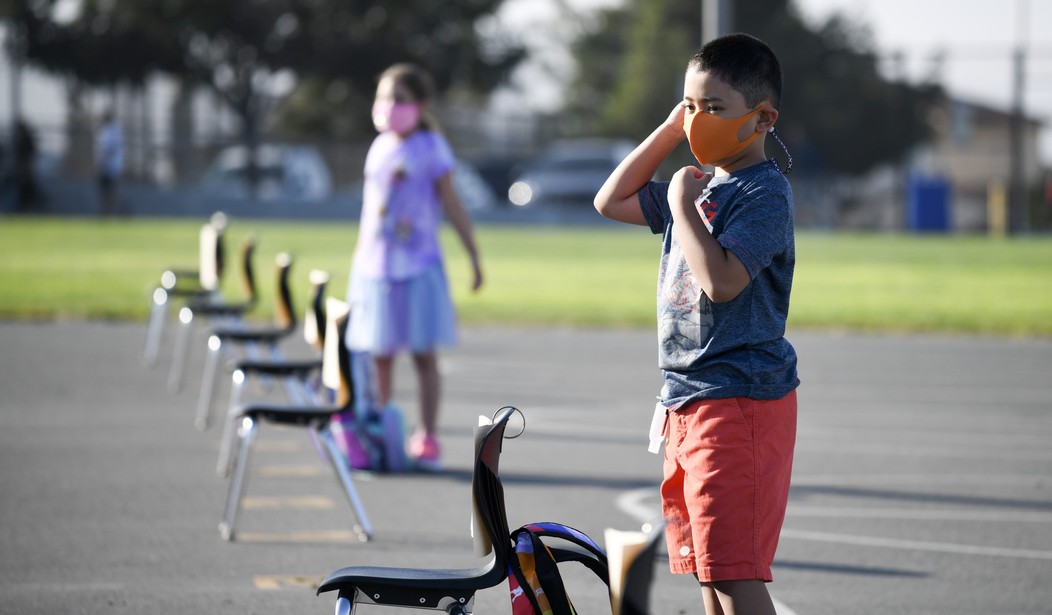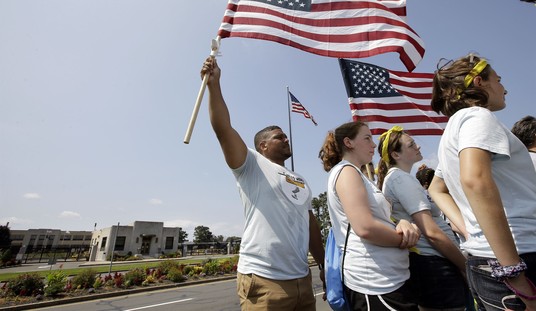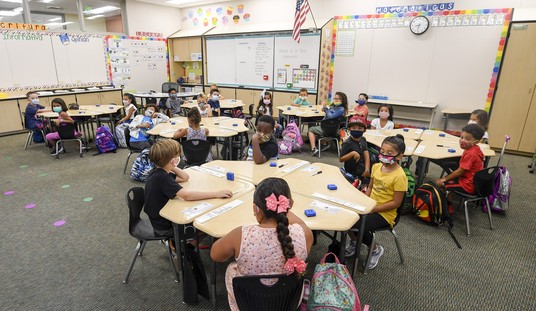It appears as though America will largely avert another union- and Democrat-caused catastrophe in the upcoming school year, as nearly all classrooms will finally be open for in-person instruction. But as the fall approaches, a crucial emerging question for local and state officials is whether mask requirements for all students is an empirically-supported policy. The CDC has recommended that students be mandated to wear masks while in school, and many districts are following that guidance -- clashing, in some cases, with other authorities and parents who prefer optional masking and oppose blanket mandates. Masking is clearly preferable to the disastrous 'virtual learning' failure inflicted upon (predominantly public school) students in many (generally blue) parts of the country last year -- but is replacing an egregiously harmful and anti-science status quo with a scientifically-questionable one the best solution?
Some generally reliable and sensible figures like Dr. Scott Gottlieb are now embracing universal (if temporary) masking for students, while other experts are challenging the science behind the position now being aggressively espoused by the White House and much of the public health bureaucracy. Appearing on Fox News earlier this week, a former CDC director said it's a "fair criticism" when opponents of mask mandates in schools note the scarcity of reliable data on the central question of whether they actually work. To wit, Katie highlighted a recent Wall Street Journal op/ed written by two doctors pushing back on the government's blanket guidance. One excerpt:
Do masks reduce Covid transmission in children? Believe it or not, we could find only a single retrospective study on the question, and its results were inconclusive. Yet two weeks ago the Centers for Disease Control and Prevention sternly decreed that 56 million U.S. children and adolescents, vaccinated or not, should cover their faces regardless of the prevalence of infection in their community. Authorities in many places took the cue to impose mandates in schools and elsewhere, on the theory that masks can’t do any harm. That isn’t true. Some children are fine wearing a mask, but others struggle. Those who have myopia can have difficulty seeing because the mask fogs their glasses. (This has long been a problem for medical students in the operating room.) Masks can cause severe acne and other skin problems. The discomfort of a mask distracts some children from learning. By increasing airway resistance during exhalation, masks can lead to increased levels of carbon dioxide in the blood. And masks can be vectors for pathogens if they become moist or are used for too long.
One of the essay's authors joined my radio show yesterday and made the case for flexibility on the question of masking students:
My interview with @MartyMakary on mask mandates in schools: https://t.co/5pxlb7cWqL
— Guy Benson (@guypbenson) August 11, 2021
In the interview, we discussed the policy recently laid out by Florida Governor Ron DeSantis, who is enduring sustained criticism from the White House and hostile media outlets (nearly all of them) on the matter of masks in schools. DeSantis has barred districts from requiring masks for all students, which some people are wrongly describing as a mask 'ban.' It is no such thing. Masks are totally permitted and optional for students, with parents getting the final say. Importantly, the DeSantis administration is not fighting school districts that broadly require or encourage masks in classrooms, so long as parents have the choice to affirmatively opt out. This is accurate:
Recommended
In other words, it gives parents choice. There will still be many people choosing to wear masks. Interestingly, Duval County (Biden won it 51%-47%), which provides the pro-active opt out, has only had 4% of kids opted out from masking so far.
— Scott Ruesterholz (@Read_N_Learn) August 10, 2021
The contours of this reasonable policy are lost on many of those attacking DeSantis, who accuse him of putting children's lives at risk. This is an extraordinary claim that requires extraordinary evidence -- and the "proof" is at best weak and debatable. We know that the total number of COVID deaths among children (aged 0-17) in the United States has been vanishingly tiny; at worst, a few hundred out of a population of tens of millions. It's true that negative complications and even hospitalizations among children who contract COVID are not unheard of, and may be increasing along with the Delta wave, but they remain extremely rare. We thus return to two key questions: Does forcing children to wear masks in schools help reduce the spread of the virus? And is the Delta variant more dangerous for children (this is important because children, including unmasked ones in schools, have been almost totally spared bad outcomes during the pandemic thus far)? On the latter question, this thread seems highly relevant:
1/ There have been increasing claims, mainly in North American news outlets, that the #SARSCoV2 DELTA variant is causing more severe #COVID19 in kids compared to previous variants
— Shamez Ladhani (@ShamezLadhani) August 9, 2021
Well, everything we know so far indicates that’s it’s *not* true. Here’s why…??
4/ So, if cases ?? in kids & if ~1 in 200 kids with #COVID19 are hospitalised then the *number* of kids with the virus in hospital will also ??. And, since a small % of these hospitalised kids will have severe #COVID19 & may need ICU care, the *number* of kids in ICU will also ??
— Shamez Ladhani (@ShamezLadhani) August 9, 2021
8/ But when you look at *rates* (% of kids with #COVID19 who are hospitalised) the red line (if anything) is lower in the current Delta peak than previous Alpha peak, which means that kids exposed to the delta variant were less likely to be hospitalised than alpha wave @jneill ?? pic.twitter.com/NCY2gWAYWS
— Shamez Ladhani (@ShamezLadhani) August 9, 2021
This pediatric infectious disease specialist concludes, "the Delta variant is more transmissible than other variants & cases have [increased] rapidly, even in kids. Around 1 in 200 kids exposed to [COVID] will be hospitalised but, if anything, it looks like delta variant might have lower hospitalization rates in kids." I'll remind you that the famously mandate-inclined UK government scoured their reams of Coronavirus data and decided this past spring that schools should remain open and that masks should not be required for children. This policy has remained in place as the Brits' Delta wave crested then plunged (a trajectory that Dr. Makary predicts will shift to America, with improvements already underway in some states hit first by the current surge). There is also some domestic data suggesting that mask mandates in schools have not made much of a difference -- and if anything, the reality could be the opposite of the new conventional wisdom:
Although there was only one lonely, single, solitary randomized controlled trial on masks in the COVID era (in Denmark), we do have U.S. data from last year.
— Will Franklin (@WILLisms) July 21, 2021
Turns out, the COVID results were better in mask-optional than in forced-mask schools. https://t.co/ttpeVg0oPW
Why wasn't one year of data enough???https://t.co/S3b8B7YNsT https://t.co/8ItOPuQ9eN pic.twitter.com/Z5QAw3EaOd
— Phil Kerpen (@kerpen) August 10, 2021
Beyond that, one of the few studies cited as conclusive evidence that masks in classrooms are effective at limiting the spread of COVID seems to have been profoundly methodologically flawed:
Must-read thread. Authors of a study that supported masking in schools had no control group. https://t.co/Msir11zp6p
— Robby Soave (@robbysoave) August 10, 2021
1)You cannot use another study as evidence for a claimed finding in your study
— David Zweig (@davidzweig) August 10, 2021
2)The Israel study was of grades 7-12; windows were closed; and all schools were exempt from masks. If anything, the fact that there was only one outbreak suggests the lack of effectiveness of masks
Yet schools in Florida, and more so throughout many parts of Europe did not and do not have mask mandates for kids, with varying age cutoffs, and there is no correlated explosion of cases originated in those schools
— David Zweig (@davidzweig) August 10, 2021
The journalist who was digging into this says that when he raised these problems with the study's authors, they cut off communication with him. Is this 'data' part (most? all?) of what the CDC relied upon to issue their recommendations? Another component of this debate is whether some of the (still very rare) pediatric hospitalizations being attributed to COVID are actually being caused by a separate condition known as RSV. Meanwhile, Professor Emily Oster -- who has done invaluable work throughout the pandemic, synthesizing and summarizing COVID risks, especially among children -- has published a new analysis that is extremely helpful. While repeatedly emphasizing the importance of adults getting vaccinated, Oster notes that the data shows that on average, children aged 0-17 have roughly the same hospitalization rates from COVID and the flu, and that the flu is more deadly than COVID (read: still not very deadly at all) among kids. Oster writes that the "million dollar question" is whether Delta changes this equation. Her answer:
It is not completely clear. People, including the CDC Director, have cited more hospitalizations among children in heavily affected areas as evidence that Delta might be worse for kids. However, with more cases, we expect more hospitalizations. We saw this rise in pediatric hospitalizations last winter, as well, without Delta. Seeing more cases is different from saying that delta increases the hospitalization rate. There is also an increase in RSV in young children in many of the same areas COVID is spreading widely, complicating the analysis. I would argue, though, that what we do know suggests the risks are in the same range. That the narrative that this is a new virus which is tremendously more dangerous for children is just simply not supported by the data...Our most significant post-Delta data comes from the UK, where the positive test rate for children up to age 11 was around 2% at the height of the Delta surge, when schools were open (largely without masks). This 2%, of course, reflects transmission from all sources -- schools, but also households.
Once again, the UK data, which vindicates their government's decision against school mask mandates, ought to be a much bigger deal as we make assessments here at home. Click through for her full risk assessment and mitigation explanation relating to these issues. It's detailed and non-hysterical, which is a welcome change of pace from most of the current "debate" over these questions. In general, it seems to me that if there is strong data showing that mask mandates in schools work well, and can help significantly reduce the risk of transmission among children -- even if their chances of severe outcomes are quite low -- it would be reasonable to require or encourage masking in classrooms, especially in areas where community spread is high. But I'm not convinced we have anything close to that strong data, and at the very least, have some pretty compelling counter-data. If you're Doctor Fauci and you're pushing mask requirements for children aged three and up, you should be able to back that up with solid data. This...wasn't that:
Dr. Fauci on why K-3rd grade should wear masks: “[I]f we all of a sudden said okay, kids, don’t wear masks, then you find out retrospectively that this virus in a very, very strange and unusually way is really hitting kids really hard, that’s the thing.” 1 https://t.co/H0TimCgyow
— Hugh Hewitt (@hughhewitt) August 9, 2021
That 'logic' could justify almost anything. Because there are still enough unknown pieces of the equation, perhaps a solid, risk-mitigating, freedom-maximizing compromise would be to permit local districts to encourage or require masks as they see fit, hopefully tied to local conditions, while offering parents opt-out alternatives for their own children, especially those kids who may be most susceptible to various known harms that can arise from masking. In other words, the DeSantis approach, albeit with different emphases in communicating the actual policy. I'll leave you with some very encouraging summer school numbers from New York and Los Angeles (both with masking, so there's no "control" group for comparison):
The overall positivity rate in New York City over the past 28 days, as Delta spread, was 3.15 percent. Among students in summer school, it was … 0.2 percent...The L.A. Unified School District has also been testing students who participated in its summer-school program from the end of June through mid-July. With 44,000 kids attending, they saw a grand total of 174 infections. Just 0.4 percent. And only 12 of those infections — 0.03 percent — happened in school, as best they can tell.
Once again, it looks like schools are the safest place for kids to be vis-a-vis COVID. What a disgrace that so many children were locked out of classrooms last year. No excuse then, less than zero excuse now.

























Join the conversation as a VIP Member